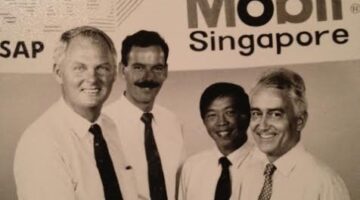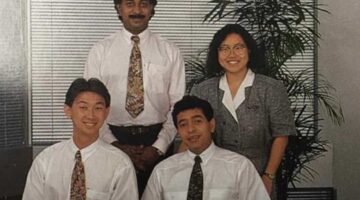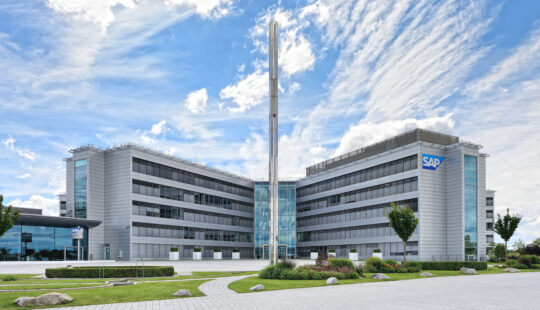To establish SAP in Southeast Asia, management relied on the instincts and gave local sales teams a long leash — starting with Singapore in 1989.
As Rudy van der Hoeven walked into the meeting room, he was surprised at being the only man present. The year is 1989, and a steering committee meeting at the headquarters of Singtel, Singapore Telecommunications, is about to get underway. As a representative of SAP, van der Hoeven is there to explain to the committee why SAP’s mainframe software, SAP R/2, is crucial for their business.
What ultimately tipped the balance in SAP’s favor — be it the growing reputation of the company’s standard software in Singapore or van der Hoeven’s charm and compelling sales techniques — is by the by: Singtel was one of SAP’s first customers in Singapore, and many other telecommunications companies in Asia followed suit.
“Singtel was a brilliant reference customer,” says van der Hoeven.
And it was a customer that both surprised and delighted managers at SAP in faraway Europe. Because back in the early days of what would become a global run on SAP software, there were no specific plans for tapping into new markets. Instead, business development simply consisted of management placing a great deal of trust in the local SAP employees and giving them a large amount of freedom to get the job done.
Dutchman Rudy van der Hoeven is also credited with kick-starting SAP’s business in Australia in the late 1980s. Whenever he traveled to and from Europe, he would stopover in Singapore, where many American and European enterprises had set up their Asian headquarters.
Hans Schlegel, who had begun building up SAP’s international operations from its offices in Biel, Switzerland, in 1984, remembers: “Rudy couldn’t resist the temptation to stop by companies in Singapore, and it wasn’t long before we had clients such as Singapore Telecom, Military Defence of Singapore, and others on our books.”
Five Customers = New Subsidiary
Dietmar Hopp, co-founder of SAP and CEO at the time, had one rule, says Dieter Matheis, former CFO: “Dietmar used to say to Hans Schlegel that if he garnered five customers, SAP would open a new subsidiary.” And that was more or less always what happened, says Matheis, “But a lot was based on instinct and trust in Hans and his team.”
Like many other companies, SAP decided to establish its Asian headquarters in Singapore. “Soon after, I found myself and my family at the Oriental Hotel in Singapore to assess and explore the market there. That was the start of one of the craziest, and most hectic and exciting, parts of my life,” van der Hoeven says.
Also involved from the beginning was van der Hoeven’s fellow countryman Henk Verkou, who would run SAP’s Asian business until the end of 1993. Together with Matheis, who dealt with the legal side of things, van der Hoeven started looking for a suitable office space.
After the official incorporation of SAP Asia on July 5, 1989, the 25th floor of the Gateway East building in Beach Road, Singapore, became home to SAP’s first subsidiary in Asia, and a base from which SAP could take on the markets in Asia and the Pacific region.
They were supported by several colleagues from SAP Switzerland — Hans-Peter Hohl, Jean-Daniel Berchier, Gunther Ottensmeyer, Malcolm Southern, and Hannes Steiner — and the first local consultants, who were hired straight out of universities in the region and then sent on a training program in Walldorf, Germany, for a year.
“Without them, we never would have been able to turn all the interested companies into happy customers,” says van der Hoeven – not in Singapore nor other Southeast Asian countries. He himself received help on the sales side from Raymond Teh, who was appointed managing director in December 1991. Mary Ann Lee, a former Singapore Airlines flight attendant, kept the operation running in the Singapore office.
Business Booms with SAP R/3
In April 1990, the first two customers in Malaysia signed SAP R/2 contracts: Malaysian postal service Jabatan Perkhidmatan Pos Malaysia and Permodalan Nasional Berhad, a government-linked investment company. Two years after that, SAP opened its Malaysian subsidiary and an office in Thailand. Its growing success made a structured approach to business essential: Dieter Matheis set up controlling departments and hired experts in finance and HR who were familiar with the local markets.
SAP’s business began to gather momentum in Southeast Asia with the launch of SAP R/3 client/server software. By 1994, SAP in Malaysia had installed eight SAP R/3 systems and was responsible for around a quarter of the revenue from the Asia-Pacific region. Its list of customers included Tenaga Nasional, Sapura Holdings, Diethelm Holdings (Malaysia) Berhad, and Caltex Malaysia.
SAP opened its subsidiary in the Philippines in the middle of 1995. Shortly after the opening of offices in Makati City, the financial center of the Philippines, the first customers – Procter and Gamble Philippines and San Miguel Corporation – went live with SAP R/3.
That same month, the subsidiary in Thailand opened its doors. In the early days, 12 employees looked after seven customers from the offices in Bangkok. But there was an issue: While the SAP R/3 system could be implemented in English in the former British colonies of Singapore and Malaysia, Thai presented the localization teams with some problems.
Werner Konik, who was responsible for software localization in Asia at the time, explains: “From the technical perspective, Thai is even more complex than double-byte languages such as Japanese and Korean. As a multi-byte language, it uses up to four characters in the database to produce one character on paper or screen.”
SAP’s developers rose to the challenge, which led to more companies based in Thailand and other Southeast Asian countries becoming SAP customers.
SAP Shows Its Commitment
Because SAP had subsidiaries in the region, many companies found it easier to choose SAP. “Customers wanted SAP to show its commitment; they wanted to be sure that there would always be SAP representatives nearby to help solve their problems,” explains Matheis. And so it was that SAP remained in those countries and helped its customers weather the financial crisis that gripped Southeast Asia in the late 1990s.
By the time the Indonesian subsidiary opened in April 1997, SAP had become a dominant player on the enterprise resource planning (ERP) market in Southeast Asia. Its market share in the countries belonging to the Association of Southeast Asian Nations (ASEAN) was more than 42%.
Selinna Chin, former country manager at market research organization IDC in Malaysia, explains: “SAP’s worldwide implementations, its crisp marketing execution, and excellent suite of products across an array of vertical industries definitely sets it apart from other vendors.”
In addition to its technical strengths, one other aspect has played a key role in SAP’s success in the region and in other Asian countries: trust. As Les Hayman, who became president and CEO of SAP Asia Pacific in 1996, put it: “At that time, we were running countries in a mode I would call creative anarchy. We had total freedom, and as long as top management at SAP felt that there was a strong commitment to the company, and we were bringing in the numbers, there was no interference.”





